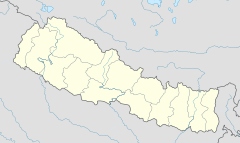Budhanilkantha Temple
| Budhanilkantha Temple | |
|---|---|
| Name | |
| Devanagari | बुढानिलकण्ठ मन्दिर |
| Geography | |
| Coordinates | 27°46′41″N 85°21′44″E / 27.7781°N 85.3622°ECoordinates: 27°46′41″N 85°21′44″E / 27.7781°N 85.3622°E |
| Country | Nepal |
| State/province | Bagmati |
| District | Kathmandu |
| Locale | Budanilkantha |
Budhanilkantha Temple, located in Budhanilkantha, Nepal, (Nepali: बुढानिलकण्ठ मन्दिर; translation: Old Blue Throat) is a Hindu open air temple dedicated to Lord Vishnu. Budhanilkantha Temple is situated below the Shivapuri Hill at the northern end of the kathmandu valley . and can be identified by a large reclining statue of Lord Vishnu. The temple's main statue of Budhanilkantha is considered the largest stone carving in Nepal.
Budhanilkantha temple, also known as the Narayanthan Temple, is situated in kathmandu. Though the temple is named Budhanilkantha, its name does not come from the Buddha; Budhanilkantha stands instead for “Old Blue Throat”. The statue symbolizes Lord Vishnu, who is regarded as one of the 'Trimurtis', along with Brahma and Shiva.
The main statue is a black stone structure carved from a single block of black basalt. The statue stands 5 meters tall (around 16.4 feet) and is positioned in the middle of a recessed pool of water, which is 13 meters (42.65 feet) long. It depicts the deity reclining on the coils of the cosmic serpent Shesha.
According to one story, a farmer and his wife once struck a figure while plowing the field, which caused it to start soaking blood into the ground. This turned out to be the figure of lost deity of Budhanilkantha, which was recovered and placed in its present position.
Another legend states that the statue was sculpted and brought to its current location in Kathmandu during the reign of the seventh-century monarch Vishnu Gupta, who controlled the Kathmandu Valley under the Lichchhavi king Bhimarjuna Dev.
It was suggested for many years that the statute floats in the pool. Indeed limited access to scientific rigour in 1957 failed to confirm or refute the claim but a small chip of the statue did confirm it to be silica based stone but with remarkably low density similar to lava rock.
The Floating statue continues to fascinate and a number of subsequent requests for access to study its physical nature have been declined.
...
Wikipedia

